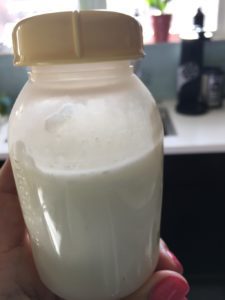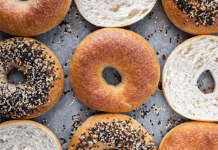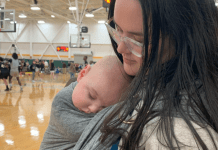Five years ago I became a mom for the first time. Like most parents, I had compiled a list of advice on breastfeeding. From classes at the Breastfeeding Center, to lotions and tips on how to produce more milk. I was ready for the teas, oatmeal, barley and special cookies, but little did I know I was going to have one of the most unspoken breastfeeding problem: Milk Oversupply. While it can be taken as a blessing, it is a challenge in itself.
When my son was born, his first latch was perfect. No pain, bleeding or anything similar to the stories I heard. I was prepared for the worst since my mom had a negative experience with both kids and was unable to breastfeed, but I was determined on exclusively breastfeeding. So far, the first night was great.
The next morning when the pediatrician came to visit, we were told that our baby had lost more than 10% of his weight and she recommended formula. We were lucky to have the breastfeeding consultant there. She had seen that his latch was great and he seemed to be eating well. At that point, the consultant recommended a pump to check on my supply. After a really short session plugged into the hospital grade pump we got what seemed to be great news: “mommy, you are ready to feed triplets”. Sounds amazing, but little did I know the implications and work that had to follow.
[quote] After a really short session plugged into the hospital grade pump we got what seemed to be great news: “mommy, you are ready to feed triplets”[/quote]
The time after getting home from the hospital was very stressful. We had visits to the pediatrician every other day to monitor his weight. After a week, we seemed to be on the right track. I was feeding without problems and his growth seemed to have normalized.
How to identify a problem that no one talks about?
As the months went by, we started experiencing some new difficulties. He would drink 10-15 minutes from each breast as was recommended, but sometimes (usually in the middle of the night) we would have an episode of projectile vomiting. The first couple of times I didn’t think it would be something that mattered, but after some time and frustration with changing sheets in the middle of the night and cleaning spit up, I started to do a little research. After some midnight googling, which could be very dangerous, I discovered the problem I had existed: Milk Overproduction.

Turns out that overproduction only affects a small percentage of moms. It seems like a blessing, but only after you learn what it is and how to manage it. As you breastfeed, the composition of milk changes. It goes from foremilk to hindmilk (light to fatty). The problem with overproduction and a bad feeding technique is that your baby could end up taking only foremilk. That was my problem and the reason for his vomiting.
Once I understood what the problem was, I was able to adjust my feeding. I exclusively breastfeed from one side at a time. The downside: a visual imbalance! Over time things got better. I would pump at work and bring back for his nanny to feed him the next day. He never liked previously frozen milk, so I would only pump as much as he would drink. I was always the person you would hate at the lactation room: the one that pumped 8 oz in five minutes while everyone else struggles to get to 4 oz.
Once he moved to a daycare I would visit him at feeding time and was blessed to dump the pump. I breastfeed him past his first birthday, still struggling to keep my production low. I once had a weekend seminar, forgot the pump and got home with mastitis. Oh, the pain! It got to the point where I could spot the signs early, take a Tylenol followed by a shower and a long nap.
What next?
When I had my second child, I was ready. I knew what needed to be my strategy and I understood how  my body was programmed. Of course, parenthood teaches you that things rarely go as planned. I came home and I was in pain every time my son was on the boob. I had no idea why, after all, I was a pro already, right? Not even close.
my body was programmed. Of course, parenthood teaches you that things rarely go as planned. I came home and I was in pain every time my son was on the boob. I had no idea why, after all, I was a pro already, right? Not even close.
My first problem was an also unspoken one. Turns out that post-partum contractions are much stronger after your second child. In my naive mind, I thought I can go with no pain medication. Wrong again! After complaining to a fellow mommy, she pointed this out and suggested some natural pain relievers (only take medicine after consulting with your care provider), which worked wonders. But some pain persisted. My breast were engorged and bleeding. I assured my mom that that was normal because of my overproduction, after all I knew what I was talking about.
Thankfully, breastfeeding consultants make home visits, which I was sure to use with both kids (one visit per child was covered partially by my insurance courtesy of ACA). The consultant explained to me that my technique was completely wrong. How could this be? I was already a pro, right? Wrong again. Turns out I completely forgot how to feed an infant and I was feeding my baby as if he was a toddler. Once again I had to relearn the basics and nod my head to an “I told you so”. After correcting my feeding position and lots of cold cabbage leaves, I felt much better. We were on track. I avoided the pump to control my supply and only pumped when I needed to leave the house.
Almost over!
It took more than two years to get the second one completely weaned, anything I tried the first time failed. Once I was free, I was able to look back and understand that even with all the information available we need to talk, consult, and share, even when you seem to have the problem everyone wants to have. Now I need to understand and come to peace with the way my body has changed after more than three years of breastfeeding, another unspoken topic.














